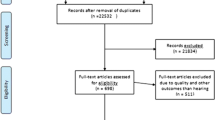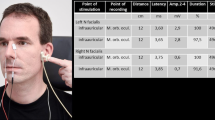Abstract
Pure-tone audiometric and impedance examinations were performed in 687 Finnish school children in the first, fourth and eighth grades (ages, 7, 10 and 14 years old) to study the sensitivity and usability of hearing and tympanometric screening examinations in schools. There were 138 children (20.1%) with a hearing loss > 15 dB in at least one frequency. Among these children, 103 were found to have pure sensorineural losses while 35 children had conductive losses. Of all the sensorineural losses, 118 of the cases involved slight high-frequency changes. Six children had hearing losses at speech range and all had been previously diagnosed. Six other children had 20–30 dB losses at 3–6 kHz, with 5 of these children diagnosed for the first time. Twenty-four of the children with conductive losses had middle ear effusions that were found at a 15 dB screening level for hearing. When the limit of normal tympanometric peak pressure was -150 daPa, 36 of 38 ears with middle ear effusions were found tympanometrically. Judging by the findings of the present study, we recommend that routine pure-tone audiometric screening for 7- and 10-year-old children in schools could be discontinued but should be continued for 14-year-old children. In contrast, tympanometry with a tympanometric peak pressure limit at -150 daPa should be used as a screening procedure for 7-year-old children on school entry.
Similar content being viewed by others
References
Aguero AL, Borria JJ, Mola M de, Asnaghi P, Cansler A, Edelstein S, Mariani L (1995) The audiometric evaluation of Buenos Aires school children. Bol Ofocina Sanit Panam 119: 292–298
American Speech-Language-Hearing Association (1990) Guidelines for screening for hearing impairments and middle ear disorders. ASHA 32 [Suppl 2]: 17–24
Augustsson I, Nilson C, Engstrand I (1990) The preventive value of audiometric screening of preschool and young schoolchildren. Int J Pediatr Otorhinolaryngol 20: 51–62
Axelsson A, Aniansson G, Costa O (1987) Hearing loss in school children. A longitudinal study of sensorineural hearing impairment. Scand Audiol 16: 137–143
Bastos I, Mallya J, Ingvarsson L, Reimer A, Anreasson L (1995) Middle ear disease and hearing impairment in northern Tanzania. A prevalence study of schoolchildren in the Moshi and Moduli districts. Int J Pediatr Otorhinolaryngol 32: 1–12
Eagles EL, Wishik SM, Doerfler LG (1967) Hearing sensitivity and ear disease in children: a prospective study. Laryngoscope [Suppl] 1–274
Finnish National Board of Health (1981) Directions for school health care (in Finnish). Dno 1392/02/81
Gimsing S, Bergholtz LM (1983) Audiologic screening of seven- and ten-year-old children. Scand Audiol 12: 171–177
ISO 8253-1 (1989) Acoustics. Audiometric test methods, part I. Basic pure tone air and bone conduction threshold audiometry. International Organization for Standardization, Geneva
ISO 389 (1991) Acoustics. Standard reference zero for the calibration of pure tone air conduction audiometers. International Organization for Standardization, Geneva
Jerger J (1970) Clinical experience with impedance audiometry. Arch Otolaryngol 92: 311–324
Kazanas SG, Maw R (1994) Tympanometry, stapedius reflex and hearing impairment in children with otitis media with effusion. Acta Otolaryngol (Stockh) 114: 410–414
Koebsell KA, Margolis RH (1986) Tympanometric gradient measured from normal preschool children. Audiology 25: 149–157
Kruppa B, Dieroff HG, Ising H (1995) Sensorineural hearing loss on children starting school. Results of a representative hearing screening study. HNO 43: 31–34
Lidén G, Renvall U (1980) Impedance and tone screening of schoolchildren. Scand Audiol 9: 121–126
Lildholdt T (1980) Negative middle ear pressure. Variations by season and sex. Ann Otol Rhinol Laryngol 89 [Suppl 68]: 67–70
Margolis RH, Heller JW (1987) Screening tympanometry: criteria for medical referral. Audiology 26: 197–208
Marttila TI (1986) Results of audiometrical screening in Finnish schoolchildren. Int J Pediatr Otorhinolaryngol 11: 39–46
Maw AR (1992) Using tympanometry to detect glue ear in general practice. Overreliance will lead to overtreatment. BMJ 304: 67–68
Melnick W, Eagles EL, Levie HS (1964) Evaluation of a recommended program identification audiometry with school-age children. J Speech Hear Disord 29: 3–13
Mourad Mi, Farghaly NF, Mohamed HG (1993) Hearing impairment: is it a public health problem among primary school pupils in Alexandria? J Egypt Public Health Assoc 68: 703–726
National Institute of Health (1993) Early identification of hearing impairment in infants and young children. Int J Pediatr Otorhinolaryngol 27: 215–227
Parving A (1984) Early detection and identification of congenital/early acquired disability. Who takes the initiative? Int J Pediatr Otorhinolaryngol 7: 107–117
Schilder AG, Zielhuis GA, Van Den Broek P (1993) The otological profile of a cohort of Dutch 7.5–8-year-olds. Clin Otolaryngol 18: 48–54
Seely DR, Gloyd SS, Wright AD, Norton SJ (1995) Hearing loss prevalence and risk factors among Sierra Leonean children. Arch Otolaryngol Head Neck Surg 121: 853–858
Virolainen E, Puhakka H, Aantaa E, Tuohimaa P, Ruuskanen O, Meurman OH (1980) Prevalence of secretory otitis media in seven to eight year old school children. Ann Otol Rhinol Laryngol 89 [Suppl 68]: 7–10
Author information
Authors and Affiliations
Rights and permissions
About this article
Cite this article
Haapaniemi, J.J. Pure-tone audiometric and impedance measurements in school-aged children in Finland. Eur Arch Otorhinolaryngol 254, 269–273 (1997). https://doi.org/10.1007/BF02905985
Received:
Accepted:
Issue Date:
DOI: https://doi.org/10.1007/BF02905985




